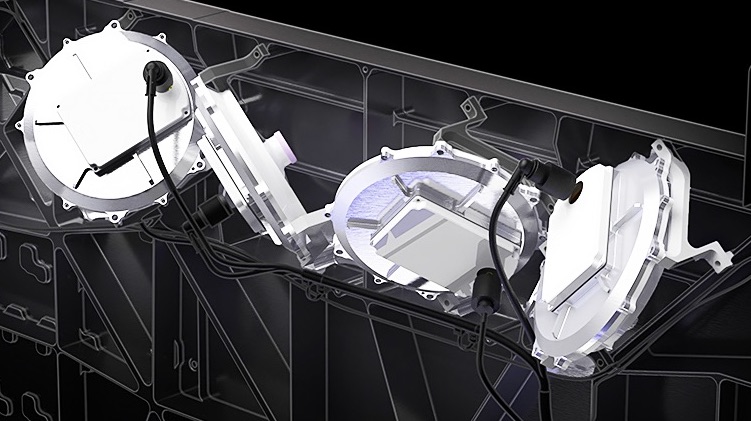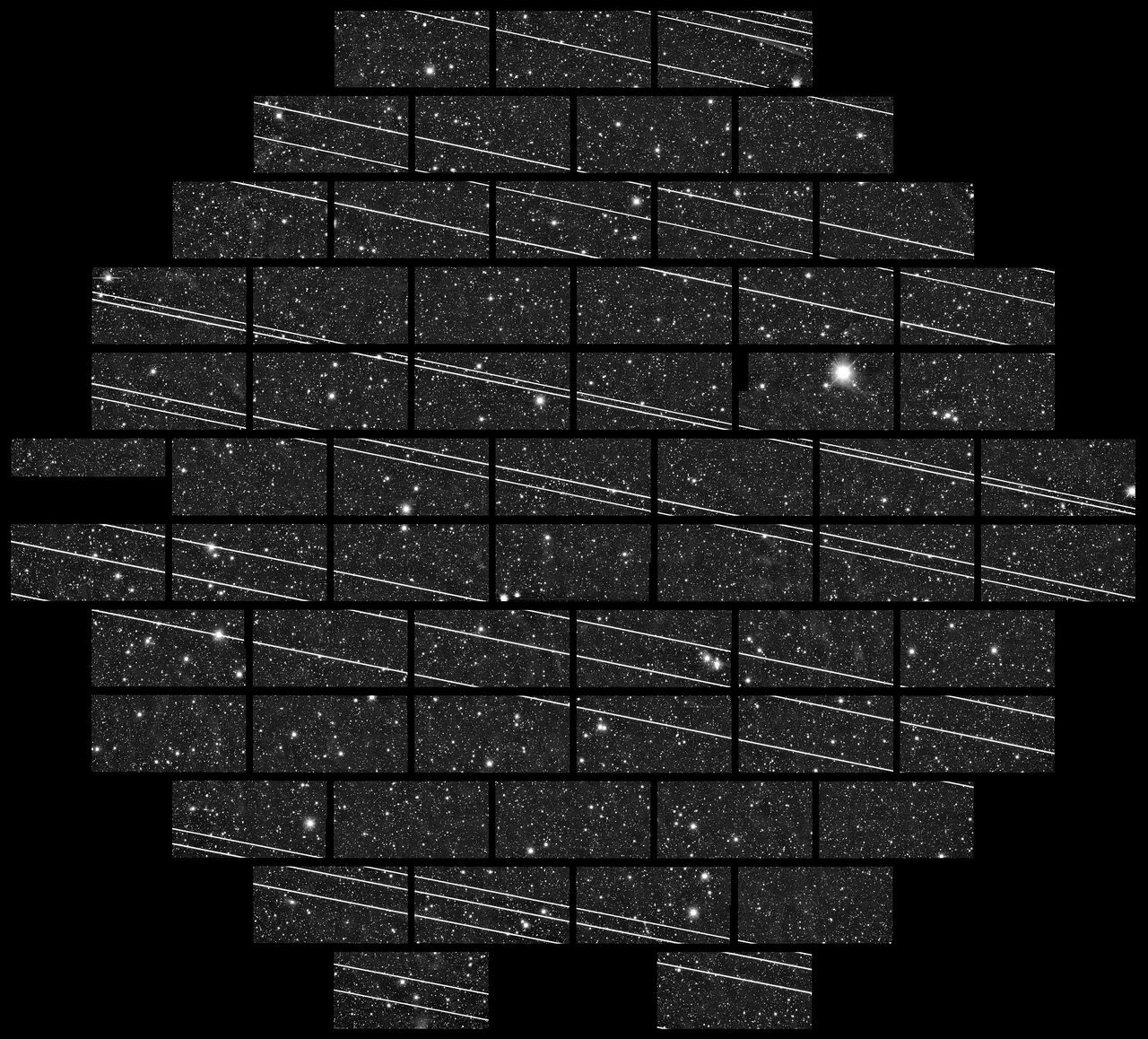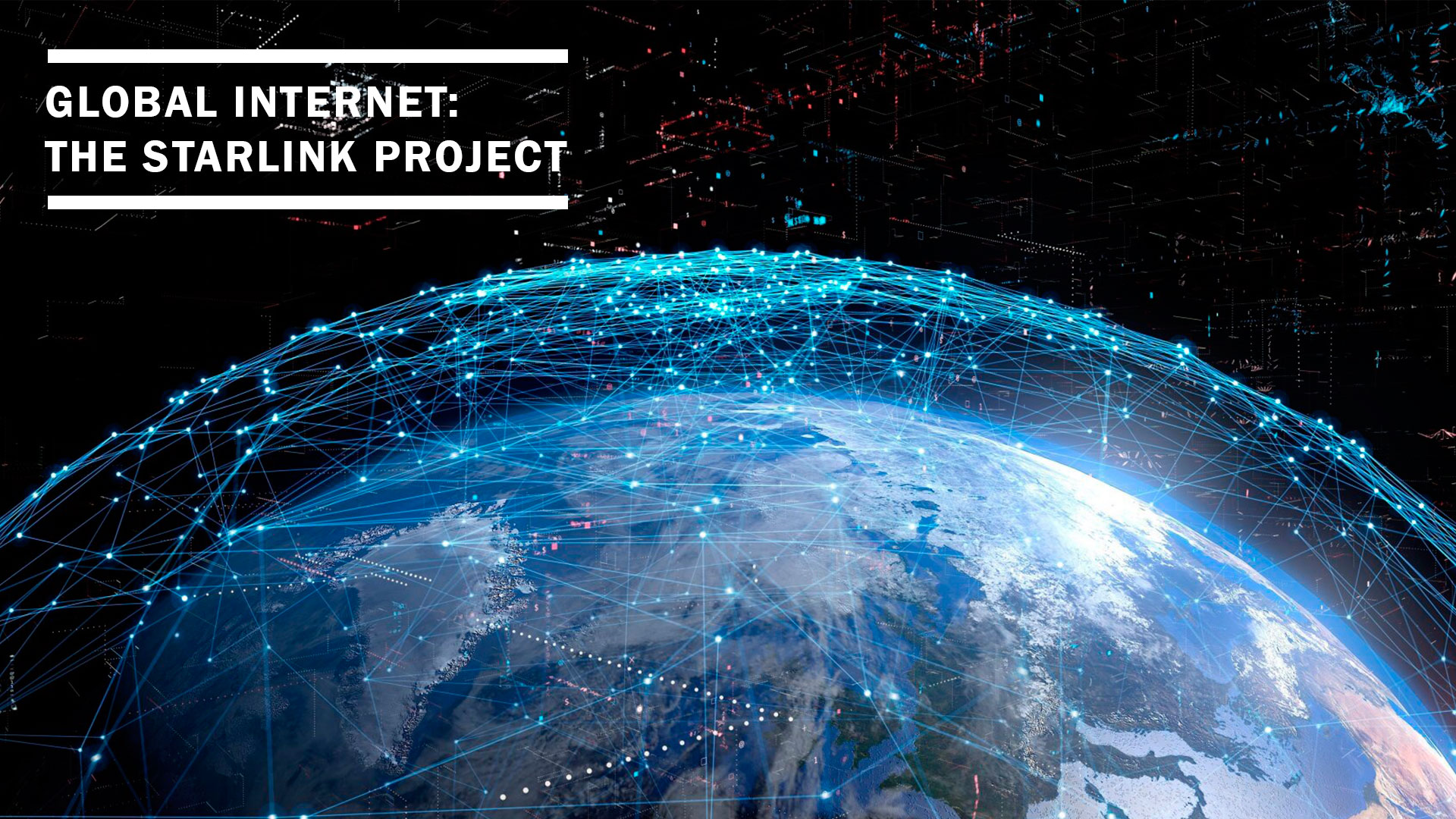Some skywatchers around the world spotted a trail of lights in their night skies the past April 19. Baffled by the sparkling objects up in the sky, people hypothesized on social media what those lights could be. Some of them, even suggested a meteor shower, a top-secret defense project or even … aliens. The following video shows the strange glowing objects a skywatcher recorded.
Animation 1: Starlink satellite train clearly visible from Earth. Credit: ViralVideoLab.
However, those theories were far from reality: those strange sparkling objects corresponded to a batch of state-of-the-art satellites the company SpaceX released for their ambitious project Starlink. Starlink is a SpaceX’s ambitious project that aims to provide high speed internet access across the globe by deploying the world’s most advanced broadband satellite constellation. The constellation will consist of thousands of small satellites in Low-Earth Orbit along with a ground network infrastructure.
Announcement
SpaceX publicly announced the Starlink mission in January 2015 to deliver low-latency broadband internet to locations where access has been unreliable, expensive, or completely unavailable. “There is a significantly unmet demand for low-cost broadband capabilities”–Musk said. Starlink officially opened the satellite development facility in Redmon, WA in 2015.
Elon Musk also stated that Starlink internet services will provide the revenue necessary to fund SpaceX’s Mars ambitions: “This is intended to be a significant amount of revenue and to help fund a city on Mars,” Musk said. “Looking at the long term, what’s needed to create a city on Mars? Well, one thing’s for sure – a lot of money. So we need things that will generate a lot of money.”
Internet around the world
As of 2020, around 41.3% of the world’s population have no access to Internet. The map below displays the distribution of Internet around the world for the year 2017.

As shown, the lowest share of internet access corresponds to under-developed countries, where the cost of building network infrastructure is unreliable.
Nowadays, the typical ways internet service providers or ISP, such as Xfinity or Comcast in the US, provide costumers access to internet include dial-up, DSL, broadband cable, optic fiber and mobile. Let us take a look at each of them:
Dial-up: uses the facilities of the public switched telephone network to establish a connection to an ISP by dialing a telephone number on a conventional telephone line. Dial-up is the slowest internet connection and currently considered obsolete.
DSL (Digital Subscribers Line): family of technologies that are used to transmit digital data over telephone lines, but the wiring inside allows for broadband transmission.
Cable: Cable modem service enables cable operators to provide broadband using the same coaxial cables that deliver pictures and sound to your TV set. Cable internet speeds are usually similar to DSL speeds, but can be even faster in some areas.
Fiber: fiber internet is the fastest widely available internet technology. It uses fiber-optic cables, which can transmit large amounts of data in light signals via small, flexible glass wires. While fiber is fast, it isn’t available in as many areas as other types of internet.
Mobile: Mobile or wireless broadband internet transmits data through radio waves from cellular towers to deliver an internet signal without using cables. This is the typical internet connection for smartphones, tablets and portable modems.
Satellite: Satellite accesses the internet via a satellite in, until now, geostationary orbits (GEO) at 35,786 km (22,236 miles) from Earth. The enormous distance that a signal travels from earth to satellite and back again, provides a delayed connection compared to cable and DSL.
When referring to the quality of service of an ISP, two key measures are bandwidth and latency. While “bandwidth” and “internet speed” are often used interchangeably, they refer to two different aspects of internet service. Internet speed is the measure of how fast information is transferred, while bandwidth refers to the capacity of an individual internet connection. While speed is variable depending on a number of factors, bandwidth is the maximum information transfer rate. Latency is the time required for a signal to travel from one computer to another computer on the network and back. In terms of internet service, latency usually means the time required for a signal to travel to the internet service provider’s (ISP’s) server and back. Thus, an optimal ISP should provide large bandwidth with low latency.

All the mentioned internet connections, except for satellite, require large ground network infrastructure to deliver internet to the costumers, either wire-based, requiring large cable networks, or wireless, where several cell towers are needed to provide wide coverage. Building and maintaining such infrastructure is costly and unreliable for some underdeveloped regions around the world.
Why rebuilding internet in space?
The total cost of the decade-long project to design, build, and deploy the constellation was estimated by SpaceX in May 2018 to be about US$10 billion. Building a masssive constellation of satellites along with logistics, maintenance and launch costs requires a large amount of capital. So there must be a compelling reason to bring about the project.
Broadband high-speed internet
The current fastest internet delivery is via optical fiber, where information is transmitted as light pulses along a glass fiber or plastic strand. The speed of light highly depends on the medium it is being transported through and is quantified by the refractive index. The refractive index is the ratio between the lightspeed in vacuum by the lightspeed in a certain medium. The average refractive index of optical fiber is around 1.467, meaning that light travels through fiber glass 46.7% slower than in vacuum. In space, however, light travels through vacuum at a maximum speed of 299,792 km/s.
Starlink aims to transmit information through inter-satellite laser communication to reduce latency. At 58.55 ms, the Hibernia Express Transatlantic Cable is currently the lowest latency fiber optic route connecting New York to London, beating an average latency of 76 ms from other providers. Research by Professor Mark Handley at University College London estimates a mean latency of 43 ms using the Starlink constellation for the same route. This low-latency connection would offer, for example, high-frequency traders at big banks competitive advantage to access better financial deals.

SpaceX’s 2016 application to the Federal Communications Commission says Starlink will offer speeds of up to a 1 Gbps. The amount of bandwidth available will be enough to support typical Internet usage, at least in rural areas, Musk said. “The bandwidth is a very complex question. But let’s just say somebody will be able to watch high-def movies, play video games, and do all the things they want to do without noticing speed,” he said.
“The challenge for anything that is space-based is that the size of the cell is gigantic… it’s not good for high-density situations,” Musk said. “We’ll have some small number of customers in LA. But we can’t do a lot of customers in LA because the bandwidth per cell is simply not high enough.”
Global coverage
How does Starlink plan to provide global broadband internet? Starlink satellites are currently being released in batches of 60 units per launch from Falcon 9 rocket. However, this number could increase with the Starship, which will be able to carry about 400 satellites per launch. The current plan for the Starlink constellation is to deploy around 12,000 satellites at different orbital shells. However, SpaceX is still updating its mission and sending new petitions to the Federal Communications Comission (FCC). Ultimately, the company has filed documents indicating it could launch between 12,000 and 42,000 small satellites to build out the network to its eventual state, depending on demands and performance. As of 22 April 2020, the first 12,000 satellites are planned to orbit in seven orbital shells ranging from a height of about 340 to 1300 km, with an initial phase of 1,584 satellites orbiting at 550 km (340 mi) in planes inclined 53.0°.
The following animation (retrieved from Professor Mark Handley) shows how the initial stage constellation may look like.
Animation 2: Starlink’s first phase orbital shell. Credit: Mark Handley
This constellation architecture will enable high-speed global internet coverage, and SpaceX plans to complete the deployment by November 2027. Forbes estimates that Starlink could be valued at a little over $30 billion, assuming 2025 revenues of about $10.4 billion and a P/S multiple of about 3x.
What technology will allow global broadband internet?
Starlink satellites were designed to be compact, cost-effective and efficient spacecraft to ensure the mission success, taking advantage of Falcon 9’s structure to deploy as many satellites as possible per launch. The lifespan of each satellite is about five to seven years, with a current production rate of six satellites per day at SpaceX’s Starlink facilities. Starlink technology features several innovative aspects to bring high-speed broadband internet around the world.
Compact design, lightweight spacecraft
Each satellite weighs approximately 260kg and features a compact, flat panel design that minimizes volume, allowing for a dense launch stack to take full advantage of the launch capabilities of Falcon 9. Currently, SpaceX is able to launch 60 satellites per flight, but in the future they plan to launch around 400 on the Starship. Starlink satellites are made of materials that will completely disintegrate during reentry when they reach end-of-life.
Ion thruster propulsion system
Starlink satellites are equipped with efficient Hall-effect ion thrusters powered by krypton that enable satellites to orbit raise, maneuver in space, and deorbit at the end of their useful life.
Animation 3: Ion thruster technology. Credit: Real engineering.
Single solar array
Starlink satellites feature a single solar array, significantly simplifying the system; solar cells are standardized, and easy to integrate into the manufacturing process. The solar array is foldable, allowing up to 60 satellites in stacked configuration to be launched at once.

Phased array antennas
With 4 powerful K

Inter-satellite laser communication
SpaceX has been secretive on the details of the inter-communication between satellites, but the last released FCC filing shows that each satellite will contain 5 individual lasers which will transmit information from satellite to satellite via light pulses. How will SpaceX ensure that the pointing requirements are met at all times for this system to work? We do not know yet, but the coming Starlink tests will tell.
Animation 4: Starlink inter-satellite laser communication. Credit: Mark Handley.
Autonomous collision avoidance
Starlink satellites utilize inputs from the Department of Defense’s debris tracking system to autonomously perform maneuvers to avoid collisions with space debris and other spacecraft based on uplinked tracking data from the Department of Defense’s debris tracking system. This capability reduces human error, allowing for a more reliable approach to collision avoidance.
Starlink satellites employ four single-axis momentum wheels for attitude control which are desaturated by magnetic torque rods.

In-house star tracker
Custom-built in-house navigation sensors tell each satellite its attitude, which helps enable precision placement of broadband throughput. Designed and built upon the heritage of Dragon, each spacecraft is equipped with a Startracker navigation system that allows SpaceX to point the satellites with precision.
Controversy
SpaceX’s Starlink project raised concern among the astronomy community. Astronomers claim that the number of visible satellites will outnumber visible stars and that their brightness in both optical and radio wavelengths will severely impact scientific observations. SpaceX announced that they are working on reducing the albedo of the satellites and will provide on-demand orientation adjustments for astronomical experiments.

Another concern is related to space debris. Currently there are over 2200 artificial satellites orbiting the Earth. Starlink aims to launch 12,000 satellites for its megaconstellation, increasing significantly the number of objects in orbit and therefore the probability of collision. However, SpaceX has claimed that starlink satellites are equipped with autonomous collision avoidance procedures, so that they can maneuver accordingly in case there is risk of collision. Moreover, the ion thrusters will be responsible for deorbiting the satellites at their end-of-life, which will completely burn up during reentry.
What is coming next?
As of April 22, 2020 SpaceX has launched 422 starlink satellites. Additional launches are expected every month this year, with the full constellation projected to be in place around 2027. Customers in the northern half of the US and Canada may be able to sign up for Starlink by late 2020. Starlink will be poised to offer internet service to most of the world by sometime in 2021.
References
3) Professor Mark Handley research
5) Federal Communications Commission (FCC)

